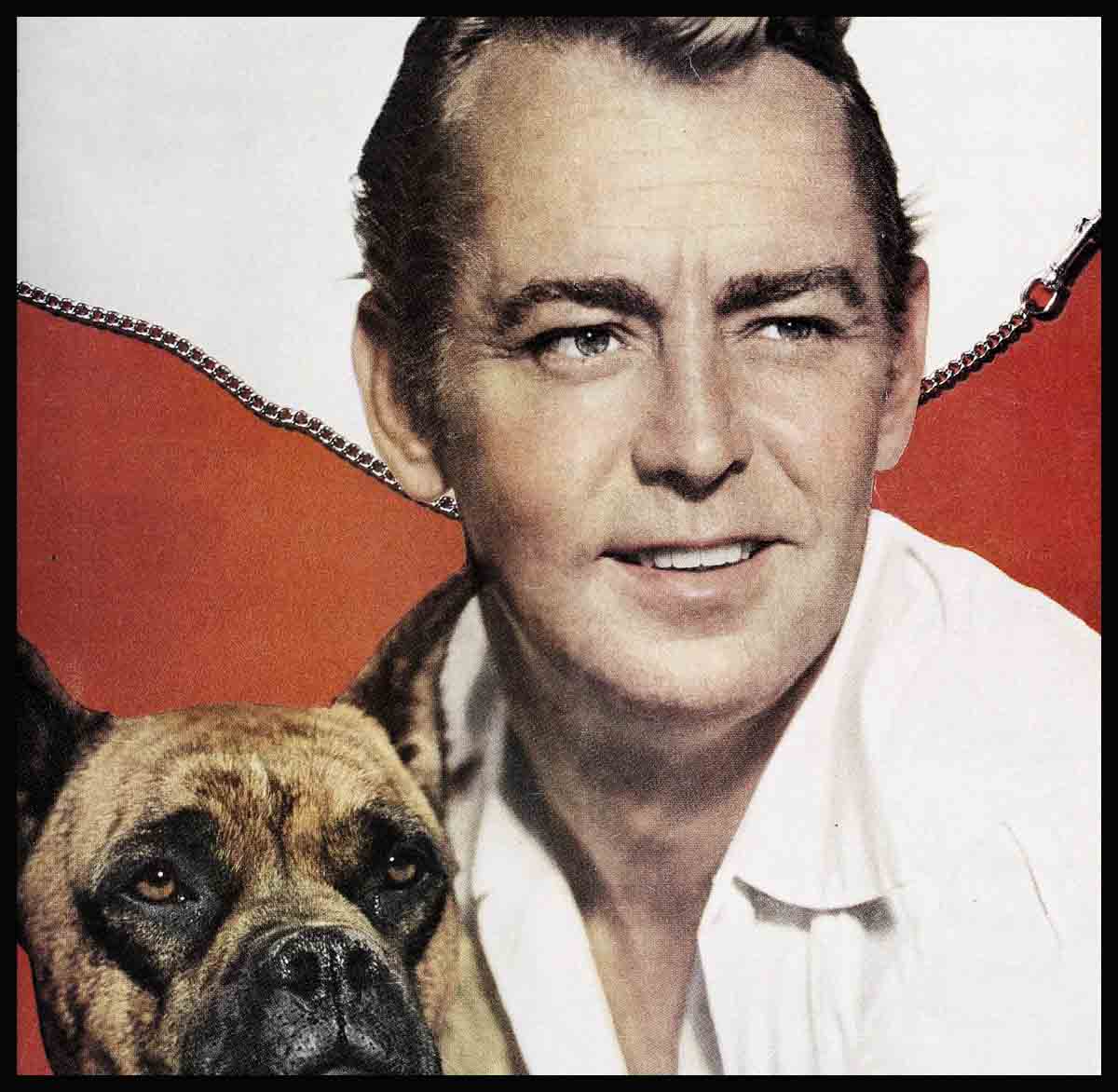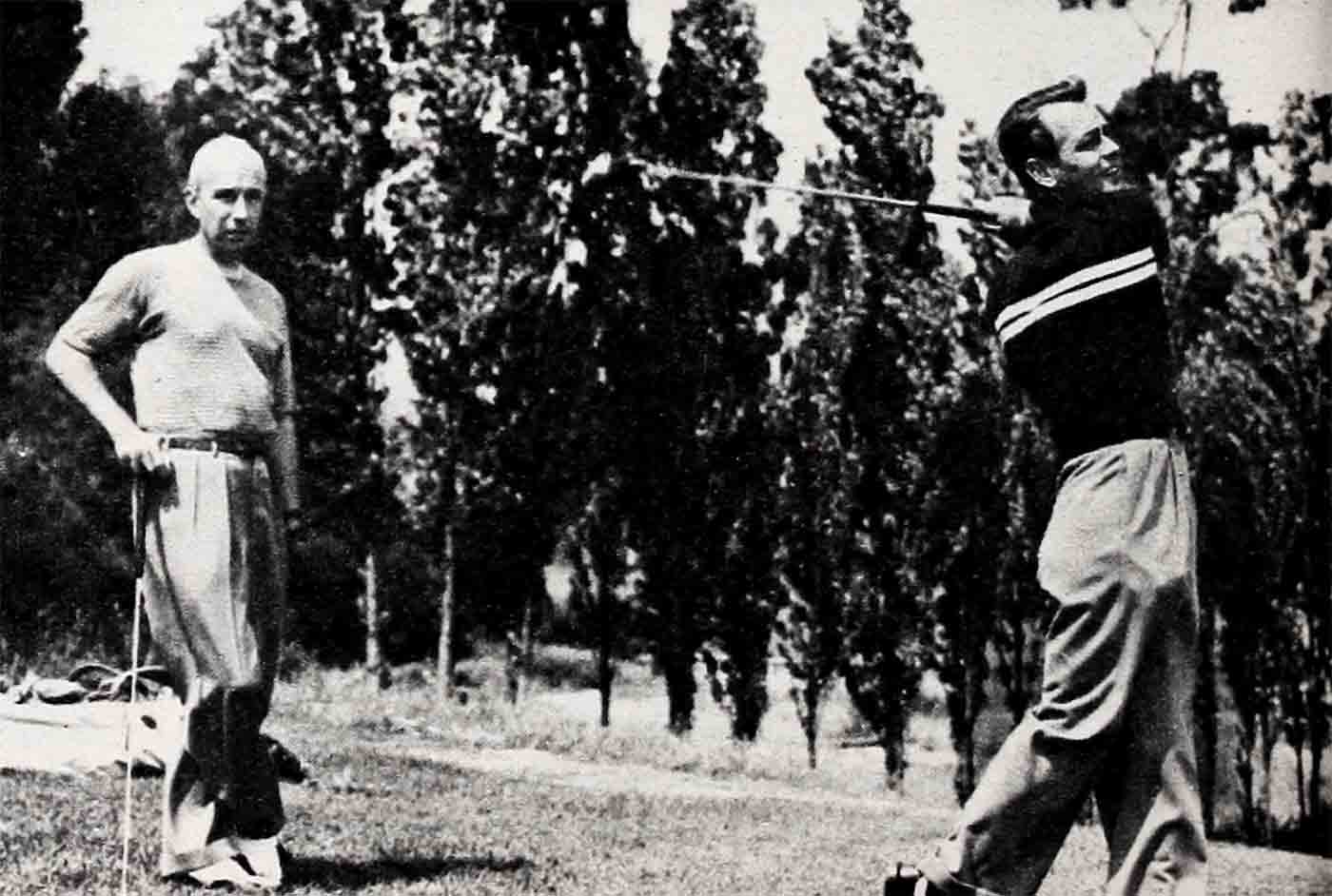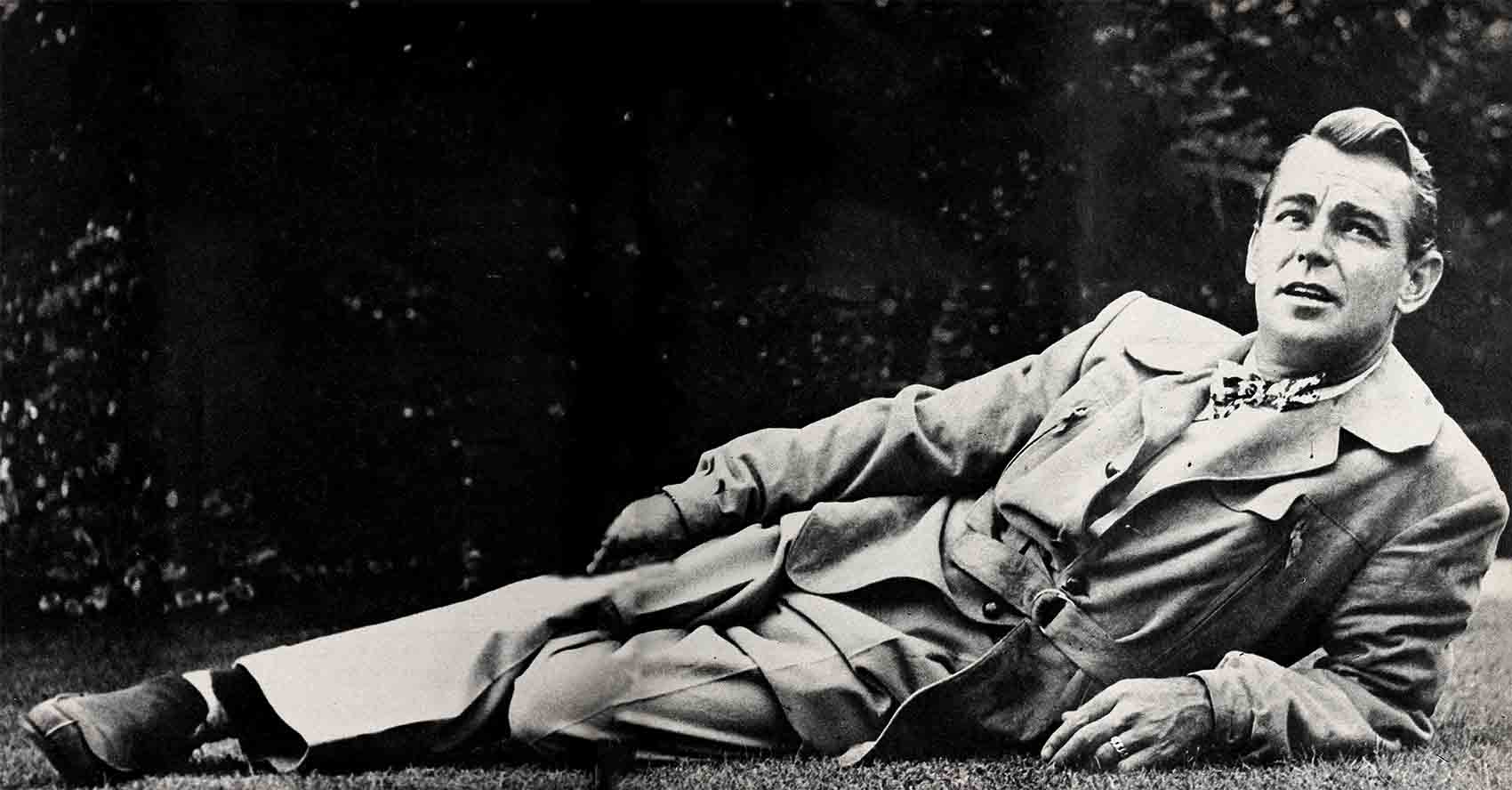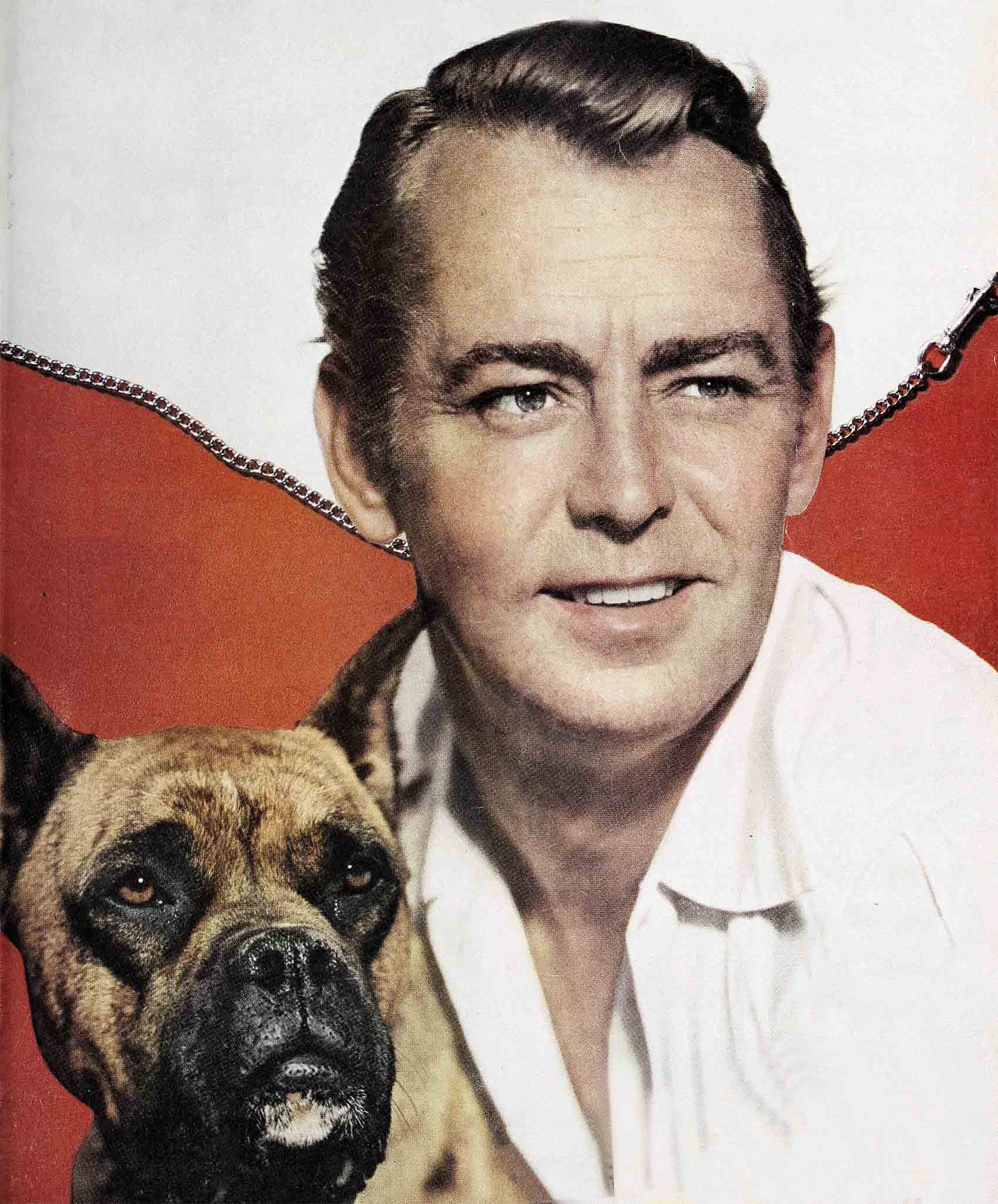
Last Laugh—Alan Ladd
“It will be different when we’re in our new home,” Sue Ladd used to tell herself. “We’re so crowded here, it’s no wonder Alan packs us out to the ranch all the time.”
And Sue would picture, as women will, the leisurely Sundays ahead, when she and Alan, their kids and their friends would enjoy the new place. She could just see Alan and herself settling down to the Sunday papers and a second cup of coffee after the children had left for Sunday School. She dreamed of the lazy hours when they all would stretch out in the sun or swim in the pool.
The day they moved to Holmby Hills it became evident Alan had been thinking in the same terms. “It’s going to be pretty swell, having all this room,” he told Sue. “I have a feeling we won’t he going to the ranch so often, that we’ll just stay home and relax.”
But it isn’t like that!
Last November, after a strenuous tour of northern California veterans’ hospitals, Alan visited friends on the Monterey Peninsula. When his host suggested a golf match at the famous Pebble Beach links, Alan—yearning for exercise and fresh air—compromised. “No golf,” he said, “but I’ll go along for the walk.”
The Pebble Beach course is one of the most beautiful in the world, sprawled along a breath-taking stretch of the Pacific Coast. But Alan—about halfway around—found himself interested more in his friend’s game than in the view.
“Give me one of those things,” he said at last, and his” host loaned him a driver.
“Unfortunately,” Alan recalls, “I hit a good ball. I was done for.”

Back home again, he began alerting his friends—borrowed a set of clubs from Vern Carstenson, some books on the game from his pal Lloyd Nolan, took a few lessons from a pro Lew Ayres recommended.
Christmas came and Sue (“my own worst enemy,” she says) gave him a complete set of sticks and a membership in the swanky Bel-Air Country Club.
“Now it’s golf-golf-golf every day he’s not working, golf jokes at the dinner table, golf books on the bedside table. I’m lucky,” Sue says, laughing, “if he calls me up to say he’ll be home late for dinner.”
“I’m lucky,” Alan retorts, “if the line isn’t busy.” This “busy” line is a squelcher, an old standby argument-stopper for Alan. Stems, he says, from the blackest, bitterest night of his life.
It was a cold, rainy, autumn night in 1943, and he had just been inducted into the Army at the induction center at Ft. McArthur. He and a million other poor guys took the long day of standing in lines for processing without grumbling too much because he knew that as soon as the processing was over he would get a five-hour pass. He had promised Sue to call her the minute he had the pass in hand. She’d pick him up at the post and he’d have a whole five hours of civilian warmth and comfort.
There was a line-up for the phone, too—the million other guys had the same idea. Alan waited his turn, trying to be patient, grabbed the phone eagerly and dialed his home number. The line was busy. He had to go back again to the end of the line—inch up again for another try. It was dark, and getting late, and the rain was coming down in sheets. He got to the phone booth again, called the house again. The line was busy.
Livid, he walked to the nearest trolley stop, got on a train heading for Los Angeles. Everything was fine until midway in the run when the train reached a wash-out in the tracks and was forced to back all the way to San Pedro.

This time Alan called a cab and rode home in style. He got there at three-thirty A.M. and he had to be back at the post at five o’clock.
Sue had a second phone line installed the next day and told no one but Alan the number. “It worked for awhile,” he concedes, “but now we have three lines and they’re all busy.”
Actually one of the reasons Alan has fallen so hard for golf is that his life—now that he has become a top-ranking star—is just about as tense and complicated as the busy phone lines would indicate.
“There are no phones on the golf course,” he says. “When you’re playing you can’t even think about anything else.” He finds that all the tensions accumulated in his busy schedule float away as he whams away at the little white ball.
If anybody had told Alan even last summer that 1950 would find him trudging daily—when he wasn’t in production on a picture—around eighteen holes of a rugged golf course, sweating his way out of sand traps and from behind unfriendly tree trunks, watching the masters with almost a bobby-soxer’s brand of admiration, talking the game, reading about it, living it . . .
“I’d have said he was crazy,” Alan sums it up himself.
Until last November, when his pals in Paramount’s publicity department used to invite him to join their Sunday foursome at the Griffith Park course, he’d run.
“Anything else you name,” he’d tell them. “Come on down to the ranch—we’ll ride horses, or the motorcycle. Get a real work-out. But not golf. That’s a crazy game.”

“One thing I was positive of when I married Alan,” his wife Sue will tell you now, half-ruefully, “was that I’d never be a golf-widow. A ranch-widow, maybe, but golf was no threat.”
Now he will play with anyone who will play with him, quite frequently his old friend Lloyd Nolan, who has taught him a great deal about the game.
On a recent round with Lloyd, Alan—who has not been brave enough as yet to keep score—decided to record his shots. They added up to a thunderous total—about twice par for the course. But not bad, Alan thought, for a beginner.
“I really like the game for the exercise, he told Lloyd gamely.
“Ordinary guy,” he said, “will walk live miles going around, swinging hard. Me, I play ten games to a good man’s one. Out of the brush—into the sand bunker. Where could I get a better work-out?”
Their caddy, Micky, an old hand at^the game, decided that both players had “set golf back a hundred years.” But he laughed when he said it.
Nolan, perhaps trying to be friendly, landed in the sandtrap at one point himself. Whaled away once—missed the ball.
“I got that sand right in the mouth,” Alan told him cheerfully.
Lloyd hit again, got out of the sand but uncomfortably close to a tree. By this time, the next foursome was approaching.
Micky, holding up a warning hand, called out: “One moment please. Don’t disrupt the motion picture industry.”
Flustered, Lloyd missed another one.
“Grrrrr. . . .” he grrrred.
“Steady now,” Micky laughed at him. “Remember, golf is a game of gentlemen.”
Alan, on the surface, at least, is the sort of calm, controlled guy who doesn’t blow up easily. But he confesses that he shoots his game high, wide and handsome when an expert is looking on.
He was teeing off one day when Bing Crosby sauntered by.
Bing stopped to admire Alan’s clubs, which he had helped Sue pick out, then stood by to observe Alan’s drive.
“I was so embarrassed,” Alan reports, “I couldn’t get the ball off the ground.”
Bing does it to everybody.

He came up behind his brother Everett one day when Everett was about to drive off on the tenth hole at the Bel-Air club. Number ten, placed smack in front of the clubhouse, is a killer. You must drive at least 165 yards to clear a hazard, and with “the eyes of Texas upon you,” as Alan puts it, it’s a tough drive to make.
Then Bing strolled up, stood leaning against a tree, smoking his pipe. “Think you’ll make it?” Bing asked casually.
In the thunderous silence which ensued, Everett dropped ten balls in the gulley. Then he walked over to his caddy, grabbed his loaded golf bag and threw it after the balls. He didn’t play again, the legend goes, for a solid year.
“Isn’t it enough,” Alan says, “to be able to sing better than anybody else?” Ladd hasn’t tackled Crosby on the greens, as yet, although he admits he has ventured out of his beginner’s class.
He was so awed by Frank Ross’s superior skill in a recent game that he was “not—worth anything” for the first eight holes. Then one good shot on the ninth kept him going to finish the eighteen.
Everyone Alan sees these days, everyone he meets, is a prospective golf partner. His friend Lynn Howard hadn’t played in ten years but agreed to go out one day “just to walk around.” He liked it. Now when Lynn telephones for Alan to set up a golf date it’s always with the phrase, “tell Mr. Hogan that Mr. Snead called.”
Alan and Lynn Howard, and “ten thousand other fans,” followed Hogan around for the four days he played in the recent California Open tournament.
“There we were,” said Alan, “running from hole to hole, looking through people’s legs trying to see the players, cold and miserable in the rain.
“You know where we ought to be,” Alan remarked at one point, “at the movies. Nice warm, dry theater, comfortable easy chairs . . .” And then Hogan approached the green and nobody talked.
“Those ten thousand people froze,” Alan reports, “you could have heard a pin drop.”
Alan has a secret hankering to play the Hogan story on the screen—and not just for the golf angle; he thinks it is a great human story. “Hogan says he is nervous in these matches,” he explains, “but he looks like ice.”
If Alan thought that watching Hogan play would improve his game, he was disappointed. He went out the next day, he recalls, took a massive swat at the ball and chopped. Observing the master added ten strokes to his own game.
But it didn’t diminish his enthusiasm. He continued to go out, rain or shine, every day that he was free. He was given an honorary membership in the Globe Country Club when his company went to Arizona to shoot location scenes for “Branded.” Then he spoiled everything by coming down with a virus infection on his one day off.
“I’m amazed you didn’t play anyway,” Sue says, reminding him that he went out one day when it was so foggy he couldn’t possibly have seen the ball.
“But I did see the ball,” he argues. “What’s more, I saw one other player. Fred Sammis.
“I—and golf—have lured Fred Sammis away from Photoplay. I have coaxed Lynn Howard away from his Buicks. I have almost convinced my old ranching pal, Chet Root, that he should sell his ranch, move into town and take up the game. But I can’t interest Sue,” Alan says sadly. “Can you imagine, she’s more interested in her house and her children.
“I bought her lessons. She took one and quit. I bought her golf dresses and spiked shoes. Can’t wear spiked shoes on these carpets.”
“Oh, be patient,” Sue said at last. “I’ll go with you soon. I’ll have to take up golf in self-defense.”
THE END
—BY PAULINE SWANSON
It is a quote. PHOTOPLAY MAGAZINE SEPTEMBER 1950




